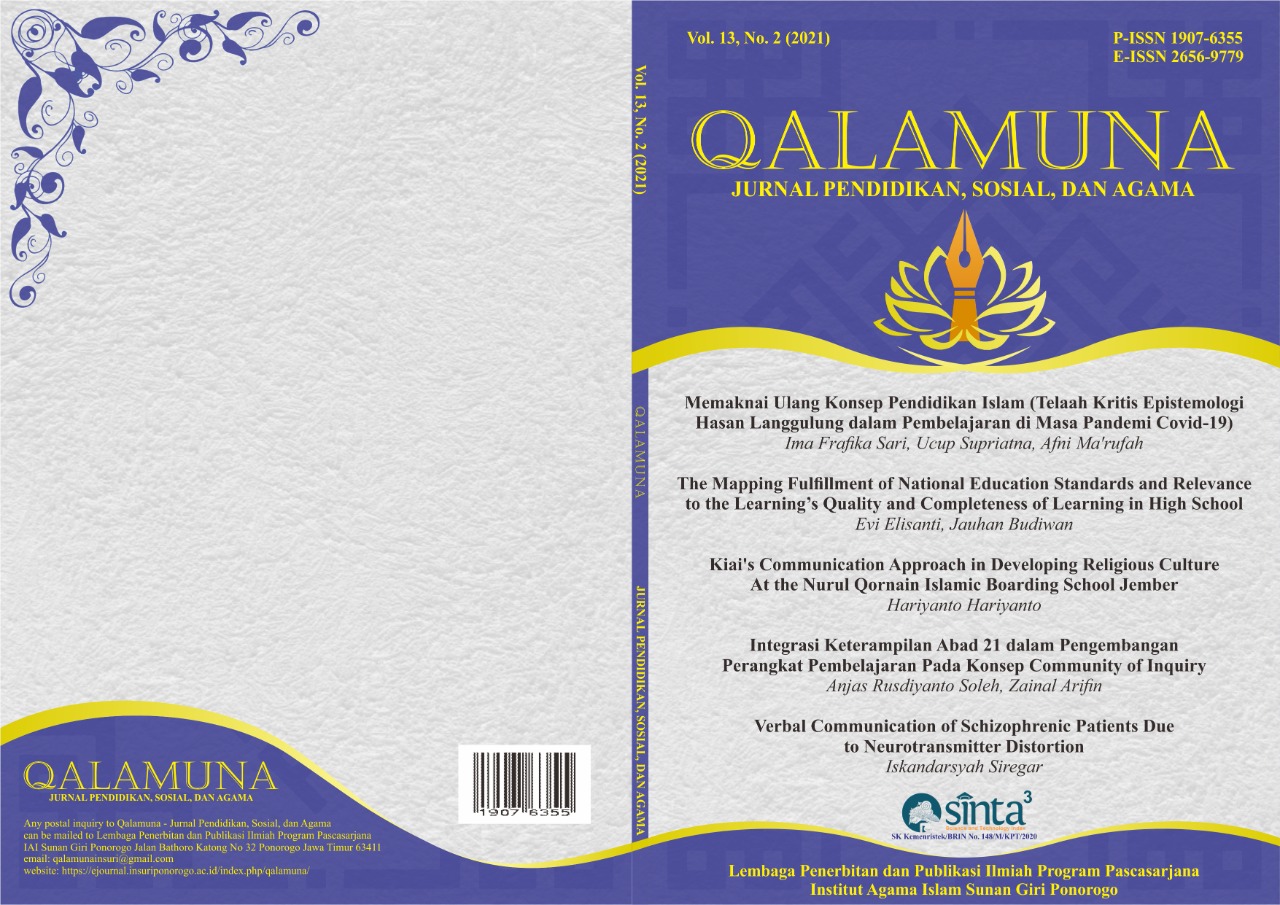Verbal Communication of Schizophrenic Patients Due to Neurotransmitter Distortion
DOI:
https://doi.org/10.37680/qalamuna.v13i2.1037Keywords:
verbal communication, schizophrenia, patient speech, neurotransmitter distortionAbstract
This study aims to analyze the verbal communication of adult schizophrenics who develop due to neurotransmitter distortion. The qualitative descriptive method of a case study is used as a method of analysis by making psycholinguistic studies a foundation. Analysis of understanding of the meaning used in this research is to use pragmatic theory with the principle of cooperation (Grice's theory). Based on the analysis results obtained conversation data that verbals follow the principle of cooperation. Schizophrenic objects are able to respond and organize the stages of language production such as conceptualization, formulation, articulation, and self-monitoring, although they are not consistent.
References
Azizah, N.R. (2013). Verbal Language Skills of Schizophrenic Patients: A Case Study. http://repository.unair.ac.id/27284/
Chaer, A. (2003). Psycholinguistics: Theoretical Studies. Jakarta: PT Rineka Cipta.
Dardjowidjodjo, S. (1997). Echa: Indonesian Children's Language Development: Twelve- Twenty-Four Months. Linguistics Meeting of the Atma Jaya Language Institute: Tenth (pp. 1-33). Yogyakarta: Canisius Publisher.
Dardjowidjojo, S. (2003). Psycholinguistics Understanding Human Language. Jakarta: Indonesia Torch Foundation.
Djajasudarma, T. F. (2010). Linguistic Methods: Research and Study Methods. Bandung: PT Refika Aditama.
Feminasari, I. (2005). The Meaning of Language by People with Schizophrenia: A Case Study at the Menur Mental Hospital in Surabaya. Malang: State University of Malang.
Garman, M. (1996). Psycholinguistics. Great Britain: Cambridge University Press.
Kweldju, S. (1997). Development of Early Functional Dimensions of Children's Writing Discourse: A Case Study. Linguistics Meeting of the Atma Jaya Language Institute: Tenth (pp. 38-69). Yogyakarta: Canisius Publisher.
Muhadjir, N. (2000). Qualitative Research Methodology. Yogyakarta: Rake Sarasin. Mukti, M. G. (1993). Development of Indonesian Speaking Ability. Jakarta: Erlangga Publisher.
Pateda, M. (1990). Psycholinguistic Aspects. Flores-NTT: Nusa Indah.
Rahardjo, M. (2010, May 07). Mudia Rahardjo. Excerpted November 06, 2012, from Mudjia Rahardjo UIN Malang Web site: http://mudjiarahardjo.uin- malang.ac.id/material-siswa/203-mengenal-dalam-dalam-about-case-study.html
Siregar, Iskandarsyah. (2020). Exploration and Implementation of the Cultural System as a Solution to National and State Problems. http://repository.unas.ac.id/id/eprint/811
Siregar, Iskandarsyah. (2021). Analysis of Betawi Language Interference on the Morphology of Adolescent Speech in Jakarta. Journal of Humanities and Social Sciences Studies, 3(8), 54-60. http://doi.org/10.32996/jhsss.2021.3.8.7
Subyakto-Nababan, S. U. (1992). Psycholinguistics: An Introduction. Jakarta: Gramedia Pustaka Utama.
Suryani, Y. (2015). Deficit of Speech Pragmatics of Schizophrenic Patients at Menur Mental Hospital Surabaya: A Study of Clinical Pragmatics. Journal of Pena Indonesia, Volume 1, No.2
Syafyahya, L. (1993). Verbal Language Ability in Children with Schizophrenia. Padang: University of Andalas.
Tarigan, H. G. (1986). Psycholinguistics. Bandung: Angkasa Publisher.
Downloads
Published
How to Cite
Issue
Section
License
Authors who submit manuscript retain its copyright and grant publisher right of first publication licensed under a Creative Commons Attribution-ShareAlike 4.0 International License (CC BY-SA 4.0) that allows others to access (search, read, download, and cite), share (copy and redistribute the material in any medium or format) and adapt (remix, transform, and build upon any material) the work for any lawful purpose, even commercially with an acknowledgement of the work's authorship and initial publication in Qalamuna: Jurnal Pendidikan, Sosial, dan Agama.












